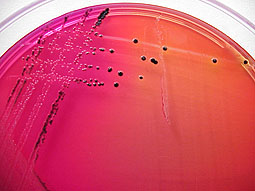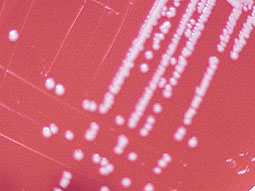Immunity against bacteria
The most effective immune mechanisms against bacteria depend on the structure of the bacterial surface and the mechanisms that induce pathogenicity. |

Appearance of GRAM negative bacteria colonies (Salmonella) in XLD culture medium.

Appearance of GRAM positive bacteria colonies (Staphylococcus aureus) in blood agar. |
Classification according to the structure of the bacterial surface can be:
|
GRAM positive bacteria |
|
GRAM negative bacteria |
|
Mycobacteria |
|
Spirochetes
|
Therefore, the most effective mechanism to destroy the bacterial membrane of the GRAM positive bacteria is phagocytosis. Due to their double lipid layer, for GRAM negative, mycobacteria and spirochetes, cytotoxicity mediated by the complement and by the cytotoxic cells is more effective. The effectiveness of an immune mechanism defends on its pathogenic mechanisms (directly or through the toxins released). Therefore, antibodies are tremendously useful against bacteria whose toxicity is linked to toxins, whilst cytotoxic mechanisms will be more effective in pathologies directly related to bacteria.
|
|
Main mechanisms of the natural and adaptive response against bacteria As well as physical-chemical barriers, which play a vitally important role in the case of bacteria, the natural response offers several important defence mechanisms. These are complement activation by the alternative pathway, especially for the GRAM negative bacteria, phagocytosis not activated by Fc, the release of certain cytokines, tumour necrosis factor and interleukin IL 1 and NK cell activation. |
The production of antibodies plays a very important role in the adaptive response. This is based on several mechanisms: Neutralization of bacterial toxins, protection of mucosae (IgA) and complement activation by the classical pathway provoking bacterial destruction or activating phagocytosis by activation of the Fc receptor. Phagocytosis is one of the most effective mechanisms in the fight against bacterial infections so the release of cytokines is of key importance in this type of infection.
|
|
Immune response against parasites
Parasitic diseases in pigs represent significant economic importance
|
MAIN PARASITIC DISEASES IN PIGS |
| EXTERNAL PARASITES: |
| Sarcoptic scabies |
| INTERNAL PARASITES:: |
| VERMINOUS ENTERITIS: Ascaris spp., Strongyloides spp., Echinorhynchus spp. |
| TRICHINOSIS: Trichinella spiralis |
| TAENIASIS: Taenia spp., Cysticercus spp. |
| SARCOCYSTOSIS: Sarcocystis suihominis |
| More parasites and images (Dr. Colin Johnstone. School of Veterinary Medicine. University of Pennsylvania) |
Due to the complexity of their structures, however, little is still known of many of the immune mechanisms involved. The main characteristics of the immune response against parasites, which can be differentiated from the response against bacteria or viruses, can be summarised in the following points:
-
Parasites contain a larger amount of antigens owing to their greater size and structural complexity.
|
-
Infections, both in the pig and in other species, are usually sub-clinical in nature, with a tendency to become chronic. The parasite usually lives for long periods of time in its host, inducing prolonged antigenic stimulation and activation of a large number of humoral and cell immune mechanisms. The most important of these are antibodies and cytotoxic mechanisms.
|
-
Parasites develop different mechanisms to evade the immune response or at least ensure that it is less effective. Amongst these strategies are: Changes in their antigenic structure during the different stages of their cycle, modification of surface antigens, or intracellular infections which do not cause changes in the membrane of the parasitized cell.
|
|
|
Main mechanisms of the natural and adaptive response against parasites
Despite the great antigenic capacity of parasites, not all immune responses induced by them are effective. This is principally due to changes in their biological cycles, which generate new antigens at each stage of the cycles. Immunology’s fight against parasitic diseases still faces great limitations.
|
The first line of action against the parasites is induced by macrophages, neutrophils and eosinophils as well as cytokines linked to the natural response such as: IL 1, IL 6, IL 12, and TNF.
In short, phagocytic mechanisms are linked to the initial phases of parasitic infection.
In the adaptive response, antibodies and cytotoxic processes are the most important mechanisms. The antibodies act by direct action, activation of phagocytosis (Fc), complement activation (classical pathway) or ADCC mechanisms. Finally, the activation of CD 8+ cells plays an important defensive role alongside several cytokines linked to inflammation, above all during the blood phase. |
|
|

